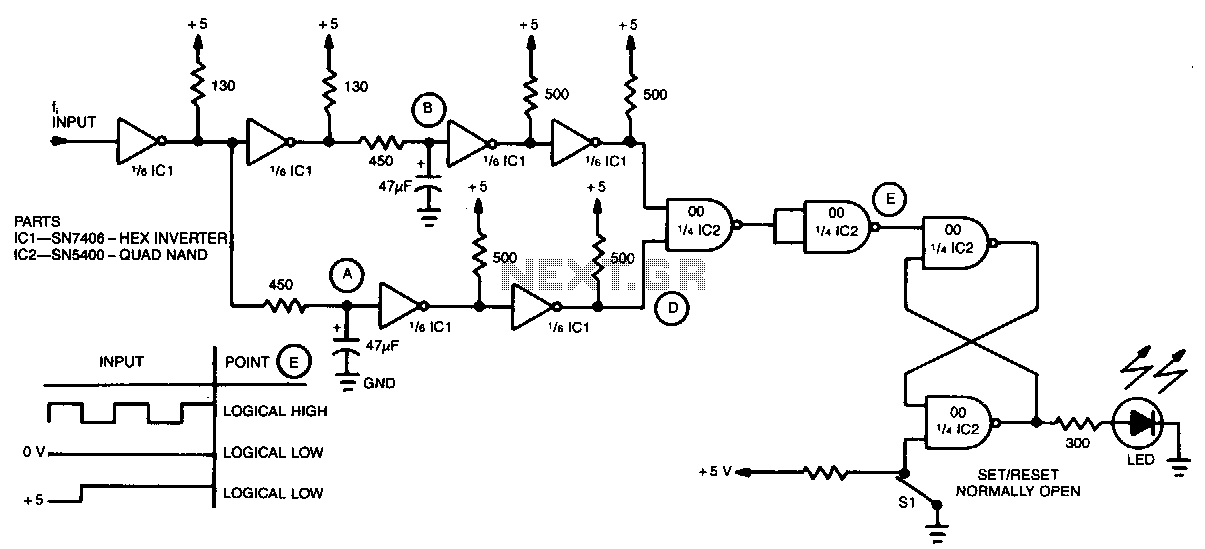
Digital-frequency-detector

A simple inverter and NAND gate can be connected to create a highly compact and reliable digital frequency detector. This circuit is capable of detecting frequencies up to 3 MHz with a 50% duty cycle. When a frequency appears at the input, points A and B detect a logical high level. Consequently, point E increases, setting the latch and illuminating the LED. If the input frequency is absent and the voltage remains at a constant high or low level, points A and B will be complementary, causing point E to decrease. This action resets the latch and turns off the LED.
The described circuit employs a combination of an inverter and a NAND gate to form a digital frequency detector that operates efficiently at frequencies up to 3 MHz. The inverter serves to invert the input signal, while the NAND gate processes the signals from points A and B. When a frequency signal is present, both points A and B output a logical high state, which triggers point E to increase. This increase activates a latch mechanism, which maintains its state even after the input signal is removed, thus allowing for the LED to remain lit.
The design ensures that the LED indicates the presence of a frequency signal. In the absence of an input frequency, the voltage levels at points A and B become complementary—one will be high while the other will be low. This complementary state causes point E to decrease, which in turn resets the latch. As a result, the LED is turned off, providing a clear visual indication that no frequency is being detected.
The circuit's simplicity and compactness make it suitable for various applications where frequency detection is necessary, such as in communication systems or signal processing tasks. The use of standard components like inverters and NAND gates allows for easy integration into larger systems and provides reliability in operation. The ability to detect frequencies up to 3 MHz with a 50% duty cycle further enhances its applicability in real-time monitoring and control systems.A simple inventer and NAND gate can be connected to yield a highly compact and reliable digital frequency detector. This circuit can detect frequencies up to 3 MHz with 50% duty cycles. When a frequency, j,, appears at the input, points A and B detect a logical high de level. Thereupon pointE increases the latch sets and the LED lights. If the input frequency is absent and if the voltage is either at a constant high or low level, points A and B will be complementary and pointE will decrease.
This will reset the latch and extinguish the LED. 🔗 External reference
The described circuit employs a combination of an inverter and a NAND gate to form a digital frequency detector that operates efficiently at frequencies up to 3 MHz. The inverter serves to invert the input signal, while the NAND gate processes the signals from points A and B. When a frequency signal is present, both points A and B output a logical high state, which triggers point E to increase. This increase activates a latch mechanism, which maintains its state even after the input signal is removed, thus allowing for the LED to remain lit.
The design ensures that the LED indicates the presence of a frequency signal. In the absence of an input frequency, the voltage levels at points A and B become complementary—one will be high while the other will be low. This complementary state causes point E to decrease, which in turn resets the latch. As a result, the LED is turned off, providing a clear visual indication that no frequency is being detected.
The circuit's simplicity and compactness make it suitable for various applications where frequency detection is necessary, such as in communication systems or signal processing tasks. The use of standard components like inverters and NAND gates allows for easy integration into larger systems and provides reliability in operation. The ability to detect frequencies up to 3 MHz with a 50% duty cycle further enhances its applicability in real-time monitoring and control systems.A simple inventer and NAND gate can be connected to yield a highly compact and reliable digital frequency detector. This circuit can detect frequencies up to 3 MHz with 50% duty cycles. When a frequency, j,, appears at the input, points A and B detect a logical high de level. Thereupon pointE increases the latch sets and the LED lights. If the input frequency is absent and if the voltage is either at a constant high or low level, points A and B will be complementary and pointE will decrease.
This will reset the latch and extinguish the LED. 🔗 External reference